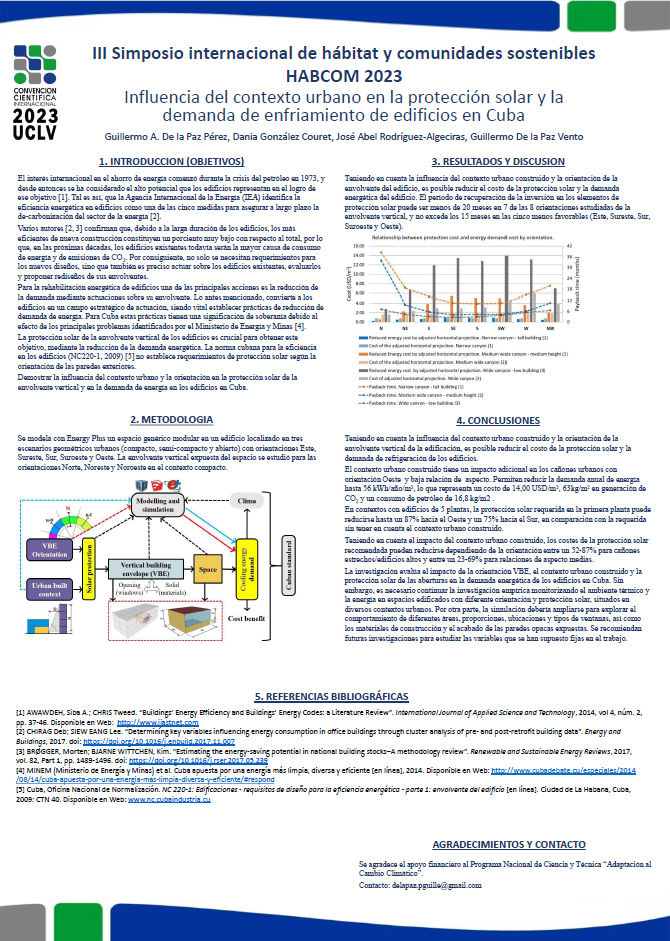Executive Secretary

II Simposio Internacional de Hábitat y Comunidades Sostenibles
HAB-COM 2023

Problemática: La protección solar de la envolvente vertical de los edificios es crucial para obtener este objetivo, mediante la reducción de la demanda energética. La norma cubana para la eficiencia en los edificios (NC220-1, 2009) no establece requerimientos de protección solar según la orientación de las paredes exteriores.
Objetivo(s): Demostrar la influencia del contexto urbano y la orientación en la protección solar de la envolvente vertical y en la demanda de energía en los edificios en Cuba.
Metodología: Se modela con Energy Plus un espacio genérico modular en un edificio localizado en tres escenarios geométricos urbanos (compacto, semi-compacto y abierto) con orientaciones Este, Sureste, Sur, Suroeste y Oeste. La envolvente vertical expuesta del espacio se estudió para las orientaciones Norte, Noreste y Noroeste en el contexto compacto.
Resultados y discusión: Teniendo en cuenta la influencia del contexto urbano construido y la orientación de la envolvente del edificio, es posible reducir el costo de la protección solar y la demanda energética del edificio. El período de recuperación de la inversión en los elementos de protección solar puede ser menos de 20 meses en 7 de las 8 orientaciones estudiadas de la envolvente vertical, y no excede los 15 meses en las cinco menos favorables (Este, Sureste, Sur, Suroeste y Oeste).
Conclusiones: Las recomendaciones que se ofrecen son pioneras en el campo de la eficiencia energética de los edificios en Cuba y deben ser integradas a las guías arquitectónicas y urbanas para obtener un impacto efectivo en la economía y el bienestar humano.
Problem: Solar protection of the vertical envelope of buildings is crucial to achieve this goal by reducing the cooling energy demand. However, the Cuban standard for energy efficiency in buildings (NC220-1, 2009) does not establish solar protection requirements based on the orientation of the exterior walls.
Objective(s): To show the influence of the urban context and orientation on the envelope solar protection and the energy demand of buildings in Cuba
Methodology: The study modelled a generic modular space into a building within Energy Plus. The building was located in three geometric urban scenarios (compact, semi-compact and open) with East, Southeast, South, Southwest, and West orientations. In addition, the exposed vertical envelopes of the space were also studied for the North, Northeast and Northwest orientations in the compact context, as it has the greatest influence on sun protection.
Results and discussion: The study demonstrated that taking into account the influence of the urban built context and the orientation of the building envelope can reduce the cost of solar protection and cooling demand of buildings. The payback period of the sun protection elements can be less than 20 months in 7 of the 8 vertical envelope orientations studied. It does not exceed 15 months in the five least favourable orientations (East, Southeast, South, Southwest, and West).
Conclusions The recommendations provided are pioneers in the field of building energy efficiency in Cuba and should be integrated with architectural and urban guidelines in the short term to achieve an effective impact on the economy and for human well-being.
Sobre el ponente

Guillermo Antonio De la Paz Pérez

Discussion